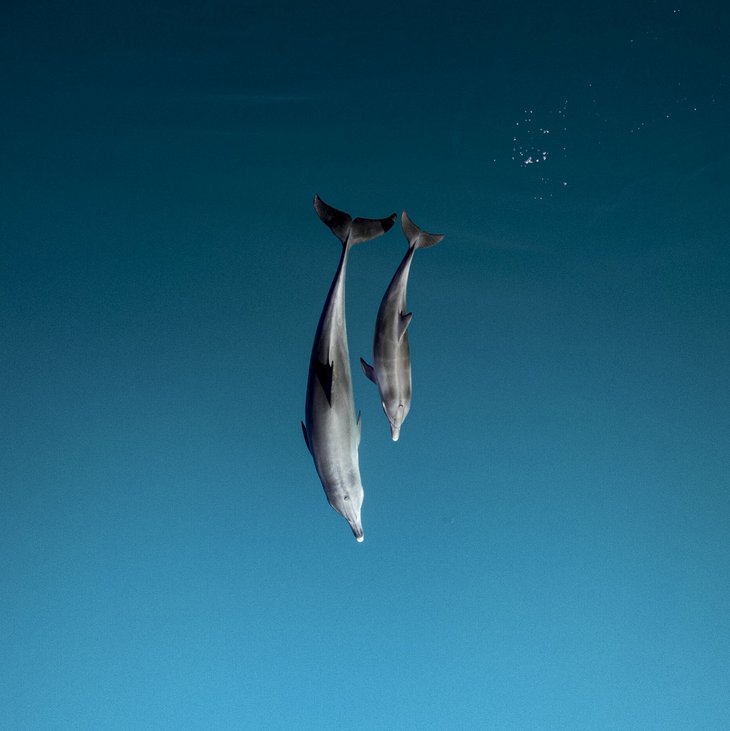
The ocean is not a quiet habitat by nature. Wind, tides and currents cause masses of water to roar, and underwater volcanoes rumble when they erupt. At the same time, many marine creatures produce sounds to communicate with other members of their species, to find the most suitable partner for reproduction, to navigate or to catch prey - from zooplankton to fish and baleen whales.
The advantage of communicating by sound: sound waves travel five times faster in water than in the air. They can travel thousands of kilometres and work just as reliably in the dark deep sea as in murky waters.
It's (too) loud under water
However, it is becoming increasingly difficult for marine organisms to successfully perceive and utilise sounds, as the natural soundscape of the ocean is increasingly being joined by man-made noises. These are either an unintentional by-product of human activities, such as harbour and ship noise, or they are generated for a specific purpose, for example in the search for oil or gas.
A general distinction is made in underwater noise between continuous noise and impulse noise. Continuous noise includes noise sources that exist permanently, such as the noise from ship propellers and ship engines. Impulse sound, on the other hand, refers to short sound events, such as underwater blasting or so-called pile driving for offshore wind farms.
Explosions are generated in marine areas used for military purposes, for example. However, they also occur when rotting munitions from the Second World War have to be blown up in the sea in order to prevent danger to humans and animals.
Private motorboats, yachts and sports equipment such as jet skis generate a lot of underwater noise, especially near the coast.
The construction of wind turbines at the ocean generates impulse-like noises in the water, for example during pile driving. The spread of this noise is to be prevented by the use of so-called bubble curtains. A ring of bubbles is placed around the pile-driving site to absorb the sound.
Oil and natural gas extraction sites also generate noise in the ocean. Some of it is impulsive, some continuous. All facilities at sea also generate noise from supply and maintenance vessels.
Sonic cannons are used, for example, to search the seabed for oil and gas deposits. They emit sound waves in rapid succession that are so powerful that they can penetrate the seabed hundreds of kilometres deep.
Sonar devices, on the other hand, are used to explore the marine environment. For example, schools of fish can be detected and shallows or submarines can be visualised. Sonar is also used in science.
The sounds of ship engines create a continuous acoustic backdrop in the sea. Added to this are the sound waves from sonars and echo sounders.
Whales sing, whistle and click, more than 800 known species of fish drum, grunt or bark, crabs snap their claws - the underwater animal world uses many sounds to communicate with its fellow species. They use sounds to navigate, find mates for reproduction, warn each other of danger or coordinate their hunting activities.
Impact of noise on the marine environment
Adapting to the increasing background noise is difficult and only possible if the noise is permanent or expected by the animals. If a louder call is not enough to drown out the noise, the only option for marine life is often to flee. Extremely loud noises can even produce sound waves so strong that marine animals lose their hearing, suffer internal injuries or even die.
Overall, however, researchers are only slowly beginning to understand the far-reaching consequences of human noise on the marine environment.
Problem identified - but has it been solved?
There are initial positive developments to minimise noise in the sea. For example, there is a noise protection concept for the German North Sea. The Federal Maritime and Hydrographic Agency (BSH) coordinates the construction of offshore wind farms in accordance with the concept and ensures that the rules are adhered to. For example, two wind farms are not built in one area at the same time so that animals such as harbour porpoises (Phocoenidae) can escape during the pile-driving work(1).
The issue of underwater noise is also addressed in the Marine Strategy Framework Directive (MSFD), which came into force in July 2008. According to this directive, a good environmental status of the seas is achieved when the introduction of energy – including underwater noise – remains at levels that do not have harmful effects on the environment(2). So far, this goal has not been met.
- (1) Konzept für den Schutz der Schweinswale vor Schallbelastungen bei der Errichtung von Offshore-Windparks in der deutschen Nordsee (BMUV), www.bsh.de/DE/THEMEN/Offshore/Meeresfachplanung/Flaechenentwicklungsplan/_Anlagen/Downloads/FEP_2022_2/Schallschutzkonzept_BMU.html
- (2) siehe Artikel 3, Absatz 8, in der Meeresstrategie Rahmenrichtlinie, eur-lex.europa.eu/legal-content/DE/TXT/PDF/







